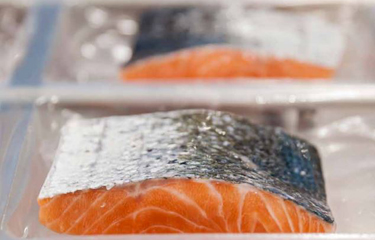Santiago, Chile-based salmon farmer Salmones Camanchaca grew first quarter revenues to USD 80.9 million (EUR 77.7 million), up 16.3 percent compared to Q1 2021, which the company mainly attributed to higher market prices and higher Atlantic salmon sales volume.
Salmones Camanchaca is a vertically integrated salmon producer that sells Atlantic and Coho salmon through five sales offices located in the main destination markets, led by the U.S., Mexico, and Japan. The company has a total of some 1,900 employees, 60 percent of whom work at its secondary processing and value-added plant at Tomé in Chile’s Biobio region.
Camanchaca’s Q1 2022 net profit reached USD 1.6 million (EUR 1.5 million) – up USD 16.8 million (EUR 16-1 million) from a loss of USD 15.2 million (EUR 14.6 million) in Q1 2021, when the company suffered USD 7.3 million (EUR 7 million) in losses due to algae blooms in the Comau and Reñihue fjords. The turnaround wasdriven by better market prices that favored sales revenue and by a USD 2.7 million (EUR 2.6 million) boost to the fair value of its biological assets. During the quarter, Camanchaca saw the price of its Atlantic salmon surge 34 percent to an average USD 6.77 (EUR 6.50) per kilogram, a USD 1.71 (EUR 1.64) per kilogram increase over 12 months, which it said was an all-time high, the company reported to Chile’s financial markets regulator, CMF.
“Demand for salmon remains strong throughout the world and consumers have added more salmon to their weekly diet, which has favored prices and offset the cost increases we've seen,” Salmones Camanchaca Vice President Ricardo García said. “In these first few months of the year, we have once again met face-to-face with the large buyers in the world at [Seafood Expo North America] in Boston and [Seafood Expo Global] in Barcelona, confirming the great interest that exists for Chilean salmon, for its high nutritional value, for its quality, and because it is more sustainable than the vast majority of other proteins.”
The company’s Atlantic salmon harvests actually fell 11.5 percent year-over-year in Q1 to 8,108 metric tons (MT) whole-fish equivalent (WFE), affected by one of its farming centers struggling with low oxygen levels, which caused extraordinary mortalities that cost Camanchaca USD 3.7 million (EUR 3.5 million) in the quarter. In response to the low oxygen levels, Camanchaca was forced to advance its harvest schedule at the affected farm, and early harvesting there accounted for 45 percent of the company’s harvested salmon in the quarter.
Camanchaca also harvested 663 MT WFE of coho salmon in Q1. Its total sales were 10,566 MT WFE of Atlantic salmon and 1,207 MT WFE of coho, down 12.4 percent and 12.2 percent, respectively. Salmones Camanchaca also participates in trout farming through a one-third stake in a joint venture with Caleta Bay and Kabsa. The JV harvested 5,000 MT of trout in 2021, a decrease from 15,000 MT WFE in 2020 due to a mandatory fallowing period. The joint venture was renewed for a term of six years starting in January 2023, but at two-thirds of its current capacity, meaning its estimated average annual capacity will be 12,000 MT through 2028.
Camanchaca’s ex-cage costs for its salmon in Q1 reached USD 4.36 (EUR 4.19) per kilo live fish, up 11.4 percent, affected by the low-harvest weight of the salmon harvested at the farm with low oxygen levels, which resulted in a lower average weight of its harvested salmon at 4.2 kilograms per fish. Camanchaca also faced a 30 percent increase in its aquafeed costs.
The company said its production target for 2022 and 2023 is in the range of 50,000 to 55,000 MT WFE. Its total salmon-production capacity salmon, which Camanchaca expects to reach in the next three years, is 65,000 to 70,000 MT WFE. Moving forward, García said Camanchaca foresees positive results through 2024 thanks to continued high demand but limited supply.
“There are some regulatory discussions going on in Chile and I don’t think there will be space for national sector growth,” García said.
“We will have stable volumes for the next three quarters and that will help the processing plant. We will also have higher volume and therefore we can achieve a better price, which gives extra room for EBIT/kg,” he said on the company's Q1 results webcast, as reported by SalmonExpert. “With the algae bloom incidents of 2021 behind us and ocean weather conditions being very favorable in the [Southern Hemisphere] fall and likely to continue in the winter, we anticipate that the next harvest will come at a lower cost than the first quarter … We will see an improvement in the average weight, a reduction in cost, and also an increase in price as we have more volume.”
However, Camanchaca is expecting to see its aquafeed costs elevated through at least the end of the year due to rising inflation, García said.
Camanchaca General Manager Manuel Arriagada said the company has received a new high-capacity wellboat, named “Orca Yka,” and will use the 79.3-meter-long vessel, which has a 2,800-cubic-meter storage capacity and handling capacity of 160 kilograms per cubic meter, for harvesting and sea lice treatment, SalmonExpert reported. The vessel is undergoing field tests and is expected to enter operations in June 2022.
Camanchaca reported a net loss after taxes for 2021 of USD 9.4 million (EUR 9 million), up from a loss of USD 31.6 million (EUR 30.3 million) in 2020. The Company harvested 40,000 MT WFE of Atlantic salmon in 2021, which was down 24.3 percent less than in 2020, when it harvested 53,000 MT WFE. It sold 46,300 MT of Atlantic salmon in 2021, which was 3.9 percent lower than in 2020. The company’s 2021 operating revenue was USD 293.7 million (EUR 281.9 million), up 15 percent from 2020 due to a 21.4 percent increase in the price of Atlantic salmon.
Photo courtesy of Camanchaca







